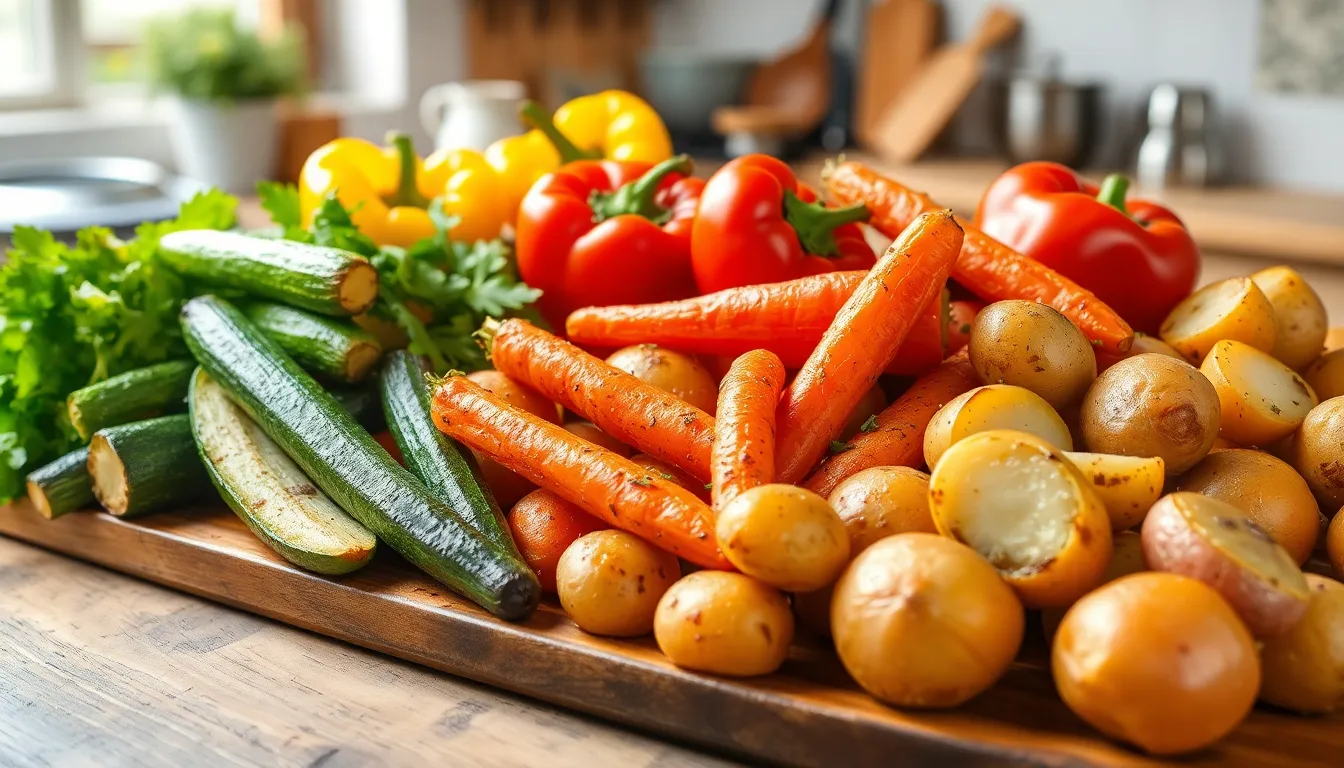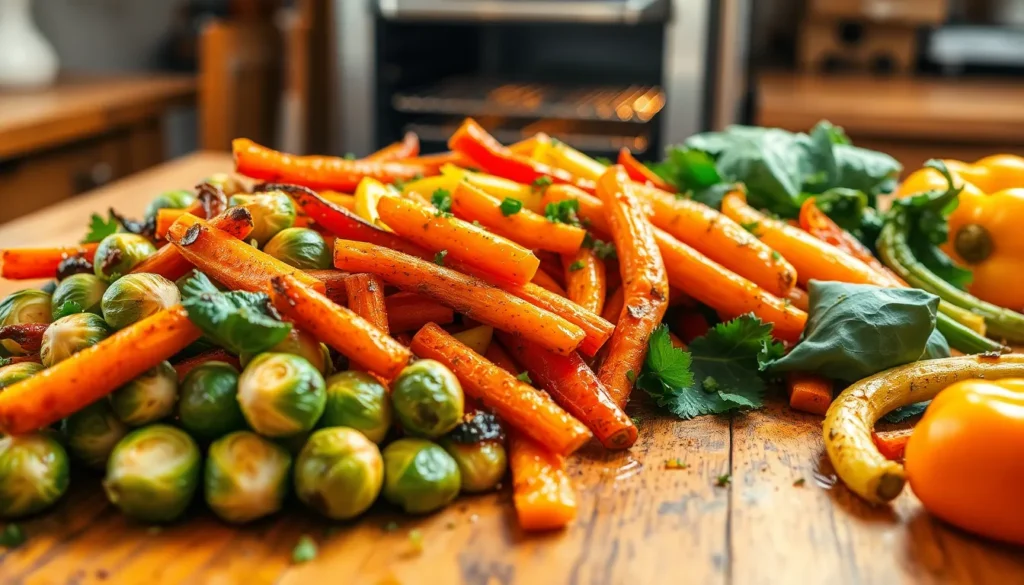Table of Contents
ToggleRoasting veggies can transform even the most stubborn of Brussels sprouts into a delightful dish that even your pickiest eater will love. But what’s the secret temperature that brings out the best in these colorful morsels? It’s not just about tossing them in the oven and hoping for the best. Finding that perfect roasting temperature is like discovering the holy grail of flavor.
Understanding Roasting Vegetables
Roasting vegetables enhances their natural sweetness and creates a satisfying texture. The Maillard reaction contributes to this transformation, developing complex flavors as the veggies cook. Choosing the right temperature is key, generally ranging from 400°F to 450°F (204°C to 232°C).
Different vegetables require varying treatment. For tender options like zucchini and bell peppers, a temperature of 400°F works well. Sturdier vegetables such as carrots and potatoes benefit from a hotter environment at 425°F to 450°F, resulting in a crispier exterior.
Cooking time also varies based on vegetable type and size. Smaller pieces tend to require 20 to 30 minutes, while larger chunks may need 30 to 45 minutes at the oven’s optimal temperature. Monitoring doneness by checking tenderness with a fork often leads to perfectly roasted results.
Additionally, tossing the vegetables halfway through ensures even cooking. This simple step prevents uneven browning and promotes a consistent texture. Adding oil, salt, and desired seasonings enhances flavor without overwhelming the natural taste.
Experimentation encourages finding a personal roasting technique. Incorporating various combinations of vegetables, herbs, and spices introduces exciting flavor profiles. The ultimate goal remains achieving a perfect balance of tenderness and caramelization, making roasted vegetables appealing to everyone, including the most selective eaters.
Ideal Temperatures for Roasting

Finding the right temperature for roasting brings out the best in vegetables. Temperatures between 400°F and 450°F allow for optimal caramelization and flavor development.
General Temperature Guidelines
Different vegetables thrive at distinct roasting temperatures. Delicate options such as zucchini and bell peppers perform well at 400°F, ensuring they cook through without burning. Heartier choices like carrots and potatoes benefit from temperatures between 425°F and 450°F, which helps achieve a satisfying crispness. Cooking times range from 20 to 30 minutes for smaller pieces, while larger chunks may require 30 to 45 minutes. Tossing vegetables halfway through cooking promotes even browning.
Factors Influencing Temperature
Several factors determine the ideal temperature for roasting vegetables. Vegetable type significantly impacts cooking requirements. Size also plays a role; larger pieces demand higher temperatures for proper cooking. In addition, the desired texture influences temperature choices; those seeking a crispier exterior should opt for higher settings. Finally, personal preferences may lead to modifications, so experimentation with various temperatures is encouraged to find the perfect balance for each unique dish.
Popular Vegetables and Their Roasting Temps
Roasting vegetables brings out unique flavors and textures. Different types of vegetables benefit from specific roasting temperatures to maximize their taste and ensure optimal cooking.
Root Vegetables
Root vegetables thrive at higher temperatures. Carrots, potatoes, and beets roast best at 425°F to 450°F (218°C to 232°C). At these temperatures, they achieve a crispy exterior while maintaining softness inside. Larger pieces may require a cooking time of 30 to 45 minutes. Tossing them in oil, salt, and seasoning enhances their natural sweetness. Even sweeter results come through caramelization, which develops as they roast. Experimentation with timing can lead to personalized results.
Leafy Greens
Leafy greens need lower roasting temperatures to maintain their delicate texture. Spinach and kale roast well at 375°F to 400°F (190°C to 204°C). Cooking times are typically shorter, averaging 10 to 15 minutes. Over-roasting can lead to a wilted texture, so monitoring is key. Oil and light seasoning complement their natural flavor without dominant tastes. Roasting leafy greens adds depth to salads and dishes, creating a delightful contrast with roasted root vegetables.
Tips for Perfectly Roasted Veggies
Selecting the right roasting temperature is essential for achieving perfectly roasted vegetables. Aim for temperatures between 400°F and 450°F, adjusting based on the type and size of the veggies. For instance, zucchini and bell peppers roast best at 400°F, while root vegetables like carrots and potatoes thrive at 425°F to 450°F.
Cutting vegetables into uniform sizes ensures even cooking. Consistency in size leads to balanced roasting, preventing some pieces from becoming overcooked while others remain underdone. Smaller chunks generally require 20 to 30 minutes, whereas larger pieces may need 30 to 45 minutes to reach optimal tenderness.
Tossing veggies halfway through the roasting process promotes even browning. This technique helps achieve the desired caramelization that enhances flavor. Don’t forget to drizzle oil over the vegetables before roasting. Oil aids in developing a crispy texture and allows seasonings to adhere effectively.
Incorporating salt and herbs can elevate the dish’s taste. A light sprinkle of salt enhances natural flavors without overpowering them, while herbs like rosemary or thyme add aromatic qualities. When roasting leafy greens such as spinach and kale, keep the temperature around 375°F to 400°F to maintain their delicate nature. Monitor their progress closely to avoid unwanted wilting or overcooking.
Experimentation is key to discovering exciting combinations. Mixing different vegetables and seasonings opens the door to unique flavor profiles. Focusing on the balance of tenderness and caramelization contributes to appealing dishes that entice even the most selective eaters.
Roasting vegetables at the right temperature can transform them into flavorful and appealing dishes. By understanding the specific needs of different veggies and adjusting the temperature accordingly, anyone can achieve that perfect balance of tenderness and crispiness.
Experimenting with various combinations of vegetables and seasonings not only enhances the dining experience but also invites creativity in the kitchen. With a little practice and attention to detail, roasted veggies can become a delightful staple that pleases even the pickiest of eaters. Embracing this cooking method opens the door to a world of delicious possibilities.







